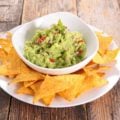Experiencing your baby’s first tastes of real food is a fun and exciting adventure.
It’s recommended that babies start foods that go beyond breast milk and formula at 4–6 months old.
Too early could interfere with the nutrition your baby needs from breastmilk or formula, while too late puts your baby at risk of missing out on the nutrients provided by solid foods.
Babies need to be able to sit with support, have good head control and indicate an interest in food (by leaning toward it or turning away). I tell my patients to follow their child’s cues, including when their child watches them eat intently and then mouths or grabs for the food.
When you do give your baby food, start a tradition of family meals and eat and enjoy food together.
Get messy: Let your child “dig in,” play with their food. Soft avocado chunks can be a good start!
Avoid choking foods: Research shows that babies who are allowed to feed themselves when they’re ready (“baby-led-weaning”) experience no increase in choking risk. However, always supervise your child when eating and avoid “choking foods” — big chunks of meat or cheese, hot dogs, whole grapes, whole nuts, raw hard vegetables and popcorn.
By 9 months of age, most infants can feed themselves and share foods prepared for the whole family with minor adaptations, such as mushing them up with a fork or cutting them into very tiny pieces.
Don’t forget water: Your little one will need water to wash food down. Give sips and follow your child’s cues.
Continue with formula/breastmilk: Foods will slowly become a larger percentage of your baby’s diet from 4–12 months old. However, breastmilk and formula pack in nutrition and should take precedence, especially before 9 months old.
It’s reasonable to give solid foods around 2–3 times a day between 6–8 months and 3–4 times daily between 9–12 months.
Babies taking breastmilk or less than 32 ounces a day of formula should be given 400 IUs a day of vitamin D. Or, if a family prefers, a breastfeeding mother can take 6400 IUs a day of vitamin D, which will transfer to the baby. Breastfeeding mothers should continue to take prenatal multivitamins.
Avoid milk and honey: The only “no” food rules are no honey before age 1, due to a risk of botulism due to immature gastrointestinal flora, and no drinking a glass of straight/liquid cow’s milk because it’s harder for babies’ immature gastrointestinal tracts to digest its protein.
Incorporate meats: Meats are good sources of zinc and iron, which babies need by 6 months old for brain development and cellular metabolism. Iron is especially important for babies who were premature or whose biological mothers were iron-deficient in pregnancy.
Use grass-fed organic meat when possible to avoid antibiotic exposure and to get more anti-inflammatory omega-3 fatty acids. Some of my patients even cook and puree liver which packs a real iron and nutrient punch! Don’t forget some wild salmon for the brain-boosting omega-3-fatty acids.
Discuss alternative protein: Let your baby’s medical provider know if you’re choosing a no-meat diet for your baby. Other iron- and zinc-rich foods include eggs, nut butters, ground seeds, tofu and ancient grains. Your baby’s medical provider will typically check your child’s iron status with a hemoglobin finger-prick test at 9 or 12 months old.
Veg out: Get your baby started early on veggies with purees of leafy greens (kale and spinach) and colorful vegetables (carrots, beets, sweet potato, squash and zucchini). Consider fruits a dessert, as they contain more sugar.
Stick with it, despite resistance you might see: Studies show that infants who were given vegetables, even when they disliked them, were more likely to enjoy those vegetables even at 3 and 6 years.
Don’t forget fat: A baby’s brain is made primarily of fat — and your baby needs 30 grams of fat every day! Give healthy fats, which are naturally found in avocado, plain whole milk yogurt, eggs, nut butters, chia and flax seeds and foods cooked with extra-virgin olive oil or coconut oil.
Be on alert for allergies: Talk to your baby’s medical provider if you think your baby may be at risk for food allergies. (Children with eczema, a known food allergy or a sibling with food allergy are at higher risk.) Your doctor may recommend a blood test and/or not waiting on those first tastes of eggs and peanut butter — and may instead recommend starting earlier, around 4–6 months.
Be aware of chemicals: Store baby food in glass or stainless containers when possible and don’t microwave in plastics. Avoid processed packaged foods that contain flavorings, colorings and preservatives. When possible, buy organic and wash fruits and vegetables in water with vinegar/baking soda to decrease fertilizer and pesticide residues.
Take care with rice: High levels of arsenic have been found in rice products. Because rice cereal has long been a traditional first food, the FDA and AAP recommend that caregivers — if they choose to buy baby cereals — serve a variety of grains, including oatmeal and ancient grains, which have higher fiber and protein contents than rice. The AAP also recommends avoiding brown rice syrup in processed foods and rice milk as a dairy substitute.
Keep trying: Now is the time to introduce lots of healthy flavors (including herbs and spices) that you want your child to enjoy later.
Keep trying, as up to 15 exposures may be necessary before a new food is accepted.
Most important, enjoy the wonder of taste together with your baby!
Dr. Allison Golnik is a board-certified pediatrician who cares for children and teens at Fairview Clinics–University Children’s.























